Attacking the Violent Crime of Arson: A Report on America's Fire Investigation Units (in English)
Synopsis "Attacking the Violent Crime of Arson: A Report on America's Fire Investigation Units (in English)"
This report compiles the best practices and common problems of fire protection and criminal justice agencies in identifying, investigating, prosecuting, and preventing arson. Commonly, the crime of arson is motivated by spite and revenge. Perpetrators strike with fire at buildings where people live, work, or socialize-causing injury, property loss, and death. Civilians and firefighters alike die in arson fires every year. Thirty years ago, arson captured media attention because so-called arson-for-profit rings were burning down decaying urban neighborhoods that had ceased to be profitable, and then rebuilding them at a substantial profit. Other high-profile cases involved arsonists who were connected to gangs and drug lords, and who set fires to intimidate their rivals or as retribution for deals gone bad. Some of the most publicized cases occurred in the cities of New York, Boston, Houston, Los Angeles, Miami, Baltimore, and others. There even were situations where neighborhood vigilantes, who were frustrated with crime and run-down buildings, took it upon themselves to torch structures to rid the neighborhood of vagrants, prostitutes, and drug dealers. Insurance companies were perceived as the main victims from intentional fires. As a crime com¬mitted against property, the economics of arson played center stage to the less well-defined statistics on injuries and deaths. Since arson fires do, on average, cause proportionately higher losses than fires from other causes, insurance companies committed many resources toward investigation and control. From establishing tip reward programs, training accelerant detection canines (ADC's), supporting arson reporting immunity legislation, and establishing the property insurance loss register (PILR), the insurance industry was a strong partner at that time. There is a dichotomy between arson as a property crime and arson as a crime against people, and that lies at the heart of today's challenges with cases of arson. As a crime, arson's long-standing definition as the willful and malicious burning of property does not do justice to the fact that today arson is usually a personal crime that is directed intentionally against specific victims. It is time for arson to be dealt with as a violent crime against persons, not just a crime against property. Today, spite and revenge dominate as the motives in intentional property fires, especially where there are casualties. Revenge-minded arsonists torch nightclubs, occupied residences, hotels, and other settings where their intended victims, and often other innocent people, are injured and killed. First responders get injured or die battling these blazes and trying to save others. Even though a portion of incendiary fires are motivated by other reasons (e.g., excitement, economic relief, peer pressure, a cry for help, and so forth) most set fires happen because someone wanted to inflict harm on another person using fire as the weapon of choice. Fire investigation units from The U.S. Fire Administration's (USFA's) project indicated that spite and revenge were the most common motives behind incendiary fires. Among project sites from the past 5 years, spite and revenge ranked as the highest leading motives, when investigation units were queried about prevailing motives.

